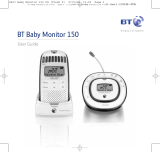
Frequently asked questions
Question Answer
Why does the baby monitor
have a smaller operating
range than the 200
meters/600 feet mentioned
under ‘Operating range’?
The specied range is only valid outdoors in open air. Inside your
home, the workable range is limited by the number and type of
walls and/or ceilings between the baby unit and the parent unit.
The maximum operating range inside your home is 50
meters/150 feet.
Why is the connection lost
every now and then?
The parent unit is probably close to the boundaries of the
operating range. Put the parent unit closer to the baby unit in a
place where it has a better reception. Please note that it takes
about 30 seconds before connection is re-established when you
move one or both units.
What happens if there is a
power supply failure?
If you have placed batteries in the baby unit, the baby
unit switches to battery operation. If the battery pack of the
parent unit is sufciently charged, the parent unit starts to run on
battery power.
Why does the parent unit
not work even though it is
placed in the charger?
When the battery pack of the parent unit is low, you have to
charge it for up to 20 minutes before you can operate the parent
unit on mains power.
Why can I not use the
parent unit cordlessly for 12
hours on a fully charged new
battery pack?
You have to charge and discharge a new battery pack three times
before it reaches its full capacity.
Why does the parent unit
run less than 12 hours on a
full charge?
Perhaps the volume is set too high. When the volume is set to a
high level, the parent unit consumes more power. Set the volume
to a lower level.
A battery pack that has been in use for quite some time gradually
loses its capacity. When this happens, you get fewer running hours
on a full charge.
If you start to use the parent unit again after some time, the
battery pack may have lost some of its charge. Place the parent
unit in the charger to recharge the battery pack.
Why do the power light and
the display of the baby unit
not go on when I press the
POWER button?
The batteries are empty. Replace the batteries.
You have not plugged in the baby unit. Insert the small plug in the
socket on the baby unit and insert the adapter in the wall socket.
Why does the battery empty
symbol on the display of the
baby unit light up and why
does the power light blink?
The batteries are low. Replace the batteries.
Why do the batteries of the
baby unit run out so quickly?
Perhaps you have set the microphone sensitivity level too high. Set
the microphone sensitivity to a lower level.
ENGLISH 15

















